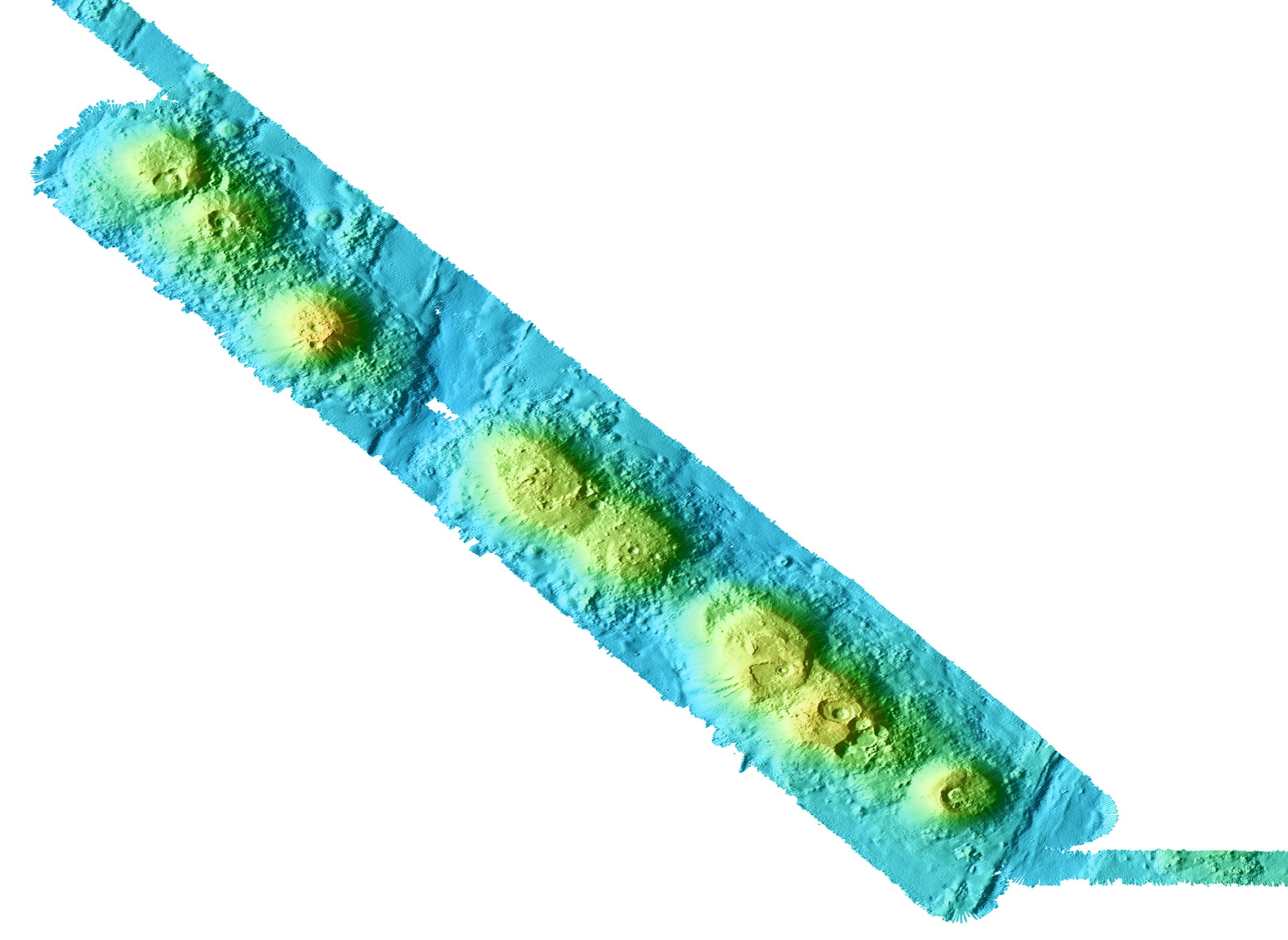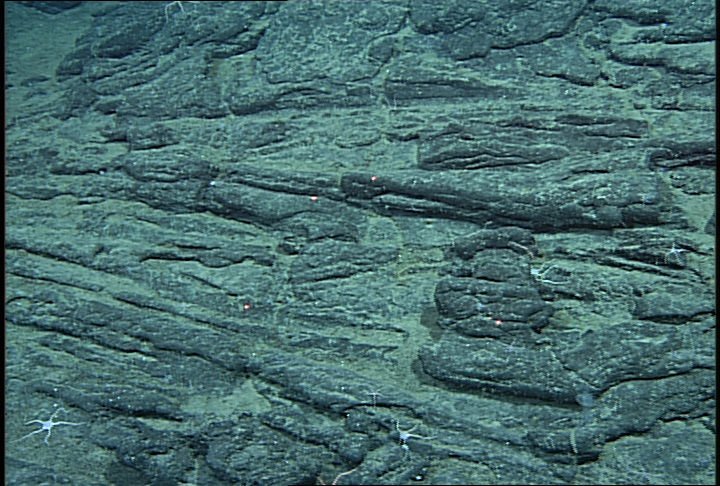 | President Jackson Seamounts |
Three chains of near-ridge seamounts off Oregon and California: Vance, President Jackson, and Taney Seamounts Map й MBARI 2000 |
|
|
Sheet flow at President Jackson Seamounts, which have complex, nested calderas.Photo й 2000 MBARI -http://www.mbari.org/volcanism/Seamounts/Default.htm |
From MBARI -http://www.mbari.org/data/mapping/seamounts/presjackson.htm
The only near-ridge seamount chain off the Gorda Ridge is the President Jackson Seamounts, located on the Pacific Plate. The most easterly volcano is located about 53 kilometers west of the ridge axis. A SeaBeam bathymetric survey imaged most of the chain (R. Embley, written communication, 1985), but poor navigation and incomplete coverage of the volcanoes limit the usefulness of the survey. A sidescan survey with the GLORIA system (EEZ-Scan 84 Scientific Staff, 1986; Masson et al., 1988) further established the rough sizes and locations of the volcanoes. A sampling cruise by the U. S. Geological Survey (Clague and Holmes, 1987) recovered pillow fragments and hyaloclastite from four volcanoes. These samples consist entirely of N-MORB that is generally more primitive than that erupted along the nearby Gorda Ridge (Davis and Clague, 2000). MBARI recently did two dives on the cluster of cones southeast of the main chain of central volcanoes. The following descriptions are summarized from Clague et al. (2000), who analyzed the Simrad data presented here in detail.
The chain consists of eight volcanoes, of which four are isolated volcanoes, less than 10 kilometers in diameter and nearly circular in plan view. The other four form two morphologically complex, coalesced flat-topped structures. In addition, a transit line to our survey crossed an elevated hummocky area of volcanic cones and flows about 13 kilometers southeast of the southeastern central volcano. The volcanoes form a linear chain and are all relatively small, with an average volume of 47▒14 km3 and a range of 24 to 68 km3. The summits of all but the second from the northwestern end are flat, and most are modified by nested or crosscutting calderas and smaller pit craters (29 in total), some of which embay the flanks of the volcanoes. In many cases the younger calderas have removed all but small remnants of the earlier crater walls. The third volcano from the southeast has a trapdoor caldera whose floor slopes down towards the southeast. The flanks and tops of many of the central volcanoes have numerous small cones. Large hummocky aprons, probably of debris, extend away from several volcanoes. The flanks of several volcanoes are also fluted or embayed by erosional gullies or landslide chutes
from http://europa.agu.org/?uri=/journals/jb/2000JB900291.xml&view=article
President Jackson Seamounts, northern Gorda Ridge: Tectonomagmatic relationship between onй and offйaxis volcanism
Alicиж S. Davis
Monterey Bay Aquarium Research Institute, Moss Landing, California
David A. Clague
Monterey Bay Aquarium Research Institute, Moss Landing, California
Basaltic lavas and hyaloclastites dredged from the President Jackson Seamounts, a 65йkmйlong, linear volcanic chain starting near latitude 42бу20''N west of the northern Gorda Ridge, are normal midйocean ridge basalt (MORB), with compositions ranging from highly depleted (0.07% K2O, 0.54 La/Sm N ) to moderately enriched in incompatible elements (0.24% K2O, 0.86 La/Sm N ). The seamount lavas are similar in many respects to those erupted at the adjacent ridge but have some important geochemical differences. Seamount lavas are concentrated toward primitive compositions with higher MgO contents (to 9.3%, Mg number 69.5) than most of the nearby ridge lavas. They also have systematically lower TiO2 and FeO and higher CaO, Na2O, and Sr at comparable MgO content than adjacent ridge basalts. Seamount basalts contain phenocrysts in equilibrium with the melt and lack compositionally diverse glass inclusions and compositional zoning common in phenociysts of most ridge basalt. Minor and trace element variability at a given MgO content indicates complex petrogenetic processes. Radiogenic isotopic ratios indicate somewhat less depleted sources than for basalt from the adjacent ridge axis. The higher Pb isotopic ratios of some lavas trend toward enriched MORB. The seamounts typically have multiple, nested calderas or pit craters, stepping downward toward the ridge axis, indicating formation in the active, nearйridge, extensional environment. The predominantly primitive nature of the lavas suggests that they pass through crustal magma reservoirs, presumably underlying the calderas, very rapidly. The lack of evidence for magma mixing suggests that batches of magma are delivered to the seamounts episodically and either solidify or are drained into ridgeйparallel faults before the next batch arrives. In contrast, lavas from the ridge axis show evidence for magma mixing involving more fractionated melts that show evidence for clinopyroxene fractionation. Despite a lack of seismic evidence for magma chambers under slow spreading centers, continuous melt zones must be present under the Gorda Ridge axis to give the ubiquitous imprint of magma mixing
from http://www.mbari.org/volcanism/Seamounts/Seam-NearRidge.htm



